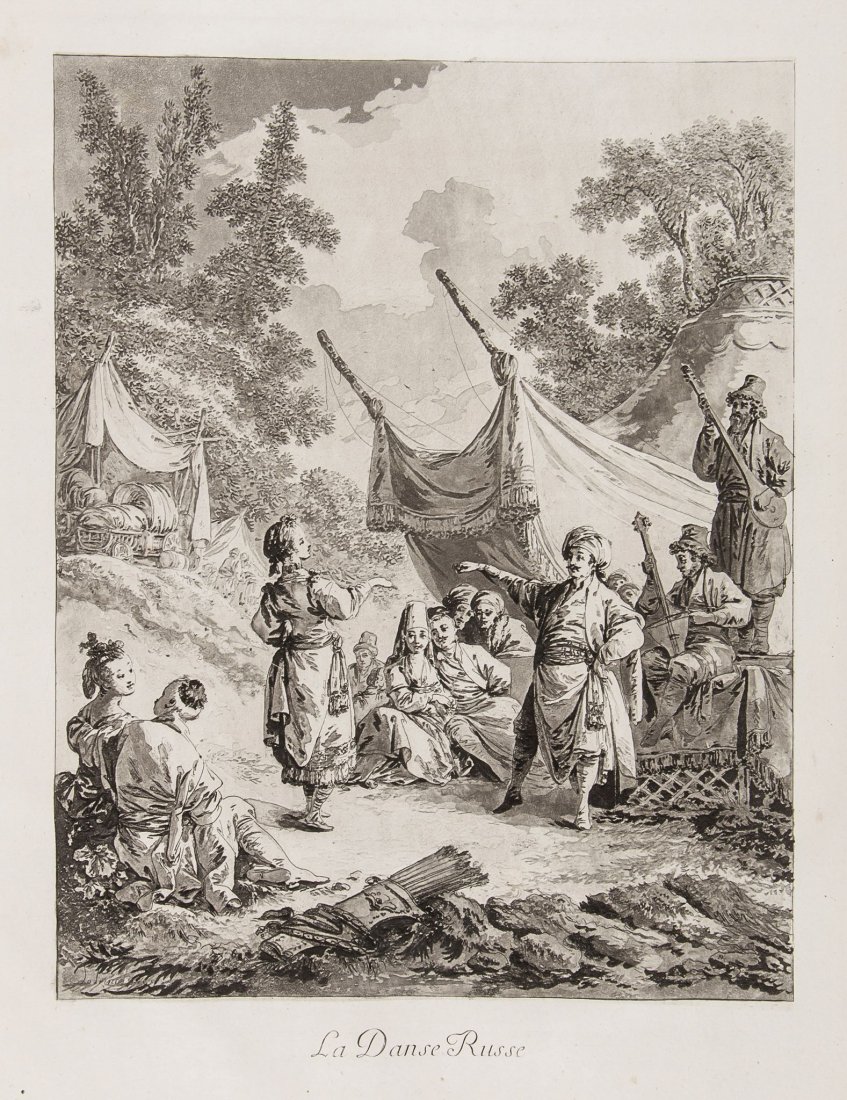
|
|
Œuvres
de Jean-Baptiste Le Prince, peintre du Roi...
Contenant plus de cent soixante Planches
gravées à l'eau-forte,
& à l'imitation des Dessins Lavés au bistre :
le tout d'après ses
compositions, représentant divers Costumes & Habillemens de différens
Peuples du Nord; où ce célèbre Artiste a sejourné quelque tems.
Portalis et Béraldi, II, 674-677, Cohen 625-627, Lipperheide 1339
etchings
with aquatint, the complete album of 157 plates* printed on 62 sheets,
grand in-folio, Basan Frères, Paris, 1782, first edition, uncut,
comprising 78 etchings (on 29 sheets) and 77 aquatints in facsimile of
watercolour wash (on 33 sheets), very fine impressions with full margins, on heavy laid paper with various watermarks, some light
foxing,
one sheet torn and repaired (affecting one image), contemporary blue
paste-paper boards, a bit worn, lacking backstrip, upper cover
detached, otherwise in quite good
condition
Provenance: a private collection S. 570 x 420 mm.

|
Le Prince was a student of
François Boucher and Joseph-Marie Vien, and is often credited as being
the inventor of
aquatint, or at least, the as being the artist who perfected it. The
subjects represented here feature a large number of works
based on his sketches undertaken during a five-year sojourn in Russia,
where he was employed by Catherine the Great between 1758 and 1763.
A
hallmark undertaking in itself, from both a technical and an editorial
point of view, this work constitutes what may well be considered a
groundbreaking quasi-ethnographic, albeit rococo illustration of many facets of Russian life in the
late 18th century. **
Full description:
Letterpress title with
decorative floral border and woodcut vignette
The suites and individual plates comprise the following:
Divers habillements des prêtres de Russie - 10 plates on 4 sheets
Les Strelits - 8 plates on 3 sheets
Divers Ajustements et Usages de Russie - 10 plates on 5 sheets
Suite de divers habillements des peuples du Nord - 6 plates on 3 sheets
Première Suite de Cris et Divers Marchands de Petersbourg et de Moscou
- 6 plates on 3 sheets
Deuxième Suite de Cris et Divers Marchands de Russie - 6 plates on 3 sheets
Troisième Suite de Divers Cris de Marchands de Russie - 6 plates on 1 sheet
Quatrième Suite d'Habillement des Femmes de Moscovie - 6 plates on 1 sheet
Divers Habillemens des Femmes de Moscovie - 6 plates on 1 sheet
Habillements de Diverses Nations - 6 plates on 1 sheet
Sujets divers - 10 plates on 4 sheets
Première Suite de Coiffures dessinés après nature - 6 aquatint plates on 1 sheet
La Vertu au Cabaret (etching) and Le Chartier et la Laitière
(aquatint) - 2 plates on 1 sheet
Deuxième Suite d'habillements de diverses Nations - 6 plates with
aquatint on 1 sheet
Divers sujets - 63 plates on 30 sheets:
Les Sens - 5 plates on 1 sheet
Le Roue vertueux (for the book by Coqueley de Chaussepierre) - 6 plates
on 1 sheet
L'Adoration des Anges after Vien, La Maitresse d'Ecole after Boucher
(the only homage paid to his masters) - 2 plates on 1 sheet
Les Nouvellistes, Le Poele, Les Oeufs Cassés, Le Berceau, La Ferme, La
Pompe, Le Cabaret de Moskou, Vue des Environs de Nerva, Les Filets,
etc.
Eleven large plates, each on a single sheet:
Jesus dans le Temple,
Ie
Pastorale,
IIe Pastorale,
Les Batteaux Russes,
Le Coche d'Eau,
La
Recreation Champetre,
La Danse Russe,
Les Pecheurs,
Les Laveuses,
Le
Repos, and
O Fortunatos nimium, sua si bona nôrint, Agricolas.
*
The title pages clearly announces more than 160 plates, although we
have never been able to trace a copy comprising more than the present
number of 157 plates.
See for example:
http://books.simsreed.com/find_books.php?all=1&stk=37816
http://www.ader-paris.fr/html/fiche.jsp?id=2416523&np=2&lng=fr&npp=20&ordre=1&aff=1&r=
http://www.doylenewyork.com/asp/fullcatalogue.asp?salelot=10BP01+++143+&refno=++733411
** Though referring seldom to the corpus of prints per se, their ethnographic nature and "authenticity" have been contested: see Stéphane Lojkine's article, La Russie de Leprince vue par Diderot,in Slavica Occitania, n°19, Toulouse, 2004, pp. 13-38 (http://utpictura18.univ-montp3.fr/Diderot/DiderotLePrince.php)


